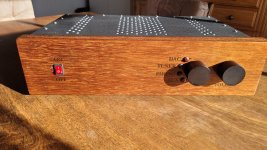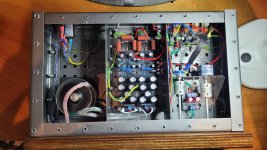Walter, et al:
It was great meeting Tom (6sX7) yesterday; we had a nice time chatting and listening. His F4 sounded terrific as well. I'm looking forward to getting together with him again.
The speakers are my take on Joe Rasmussen's Elsinore Mk. VI (MFC) design. I'm besotted by them. Very highly recommended.
Regards,
Scott
It was great meeting Tom (6sX7) yesterday; we had a nice time chatting and listening. His F4 sounded terrific as well. I'm looking forward to getting together with him again.
The speakers are my take on Joe Rasmussen's Elsinore Mk. VI (MFC) design. I'm besotted by them. Very highly recommended.
Regards,
Scott
So glad you like it, Anand! That reminds me, I owe another thank-you-much to the MakerSpace at Syracuse University -- the design is all mine, but their laser engraver is what allowed it to come to fruition.@bonacciomj
Absolutely wonderful front panel design! Enjoy and please let us know your subjective commentary versus other amps you have in your stable/ have listened to.
Best,
Anand.
As to the sound, there are certain aspects that were surprising and some that were more expected. I've gotten to compare it against several amps that all just so happen to make 150Wpc -- my old McIntosh MA6850 integrated amp, a Hegel H190v integrated, and one that I see you are familiar with, a pair of Orchard Audio Starkrimson Premium Mono amps. Despite its reputation as a brutally honest, revealing-to-a-fault amplifier, the F5T is actually quite forgiving, with a slight touch of warmth to it, compared to these other amps. I think in terms of top-to-bottom tonal accuracy and vocal clarity the F5T is perhaps the best amp, ever, period. It still is revealing, though, in that a change of source or preamp componentry is more readily obvious than with other amplifiers. And the F5T has the best subjective sibilance performance, to boot.
Its shortcomings, which I did not expect and in fact thought would be its strengths, are imaging and soundstaging. I attribute this to two things: lack of output power and lack of H2 tuning. My speakers are inefficient, but otherwise easy to drive -- about 84 or 85 dB at 1 watt, with a benign impedance curve. They really seem to create a bigger, wider soundstage only if they get a fair bit of power. I will hopefully have the opportunity to try the F5T with a pair of Focal speakers that have an efficiency of 89dB/w but drop as low as 2.9 ohms, so we'll see if the First Watt likes them better. I also hope to tune the THD spectrum to more closely mimic that of the original F5, with the 2nd harmonic tuned to be of the "negative" orientation. I hope those tweaks could perfect this (otherwise world-class) amp. Maybe one day I'll do some parts tweaks, oversize the power supply, etc., but not any time soon.
It's a very interesting amplifier. I'd say sonically, one could regard it as a tube amp but without any of the (many) deficiencies that tubes have. The F5T, if it were a commercial product, lies pretty firmly past the knee of the price vs. performance curve, so one could spend much, much more and not improve things very much at all. In short, it's a truly fabulous amplifier, with a couple of unexpected traits -- I still have much to learn, it seems!
I'd be interested to hear if your experiences are similar or different to mine, btw.
Matt
Matt,
Thanks for your wonderful synopsis. The F5M and F5 are both next to be installed in my NPXP, just as soon as I am done listening to the F6D and posting my subjective summary (and a few objective measurements as well).
Again your F5T front panel is absolutely splendid. Looking forward to your future builds.
Best,
Anand.
Thanks for your wonderful synopsis. The F5M and F5 are both next to be installed in my NPXP, just as soon as I am done listening to the F6D and posting my subjective summary (and a few objective measurements as well).
Again your F5T front panel is absolutely splendid. Looking forward to your future builds.
Best,
Anand.
Ooh, I was not aware of your NPXP project -- I'm going to have to spend some time over on that thread, very nice work!!
I also have a preamp in the works with a similar front panel design and matching color scheme -- it's an Erno Borbely all-JFET line amp called the "Super Buffer." I really should get on the horse and finish that up. I'll be sure to share some pictures when it's all done, too.
Matt
I also have a preamp in the works with a similar front panel design and matching color scheme -- it's an Erno Borbely all-JFET line amp called the "Super Buffer." I really should get on the horse and finish that up. I'll be sure to share some pictures when it's all done, too.
Matt
Very nice 👍Pics or it didn't happen, right?
I can't believe I still haven't posted pictures of the finished project -- I distinctly remember completing the amplifier and intending to make a post about it.
Anyway, the amp in question is a First Watt F5 Turbo, of the v2.5 variety (so in other words, doubling up on the output MOSFETs as in v2, plus using the cascode transistors as in v3).
Some thanks are in order: thanks to Nelson, of course, for giving us this design for free. I also owe a thank you to Randy Thatcher, whose power supply and rectifier snubber PCBs are in use in my amp. (He's a great guy btw - even took the time to talk to me on the phone about what I'd need and how to use the boards properly. Thanks again, Randy!) Similarly, the folks at the DIY Audio Store deserve props for putting the amp PCBs and matched FET kits up. I also want to thank you all, as the members of this forum are really what make projects like this viable. Special kudos go to the likes of 6L6 and Zen Mod, whose involvement in this site have been instrumental in getting my (and countless others') amps working.
Without further ado, here are pictures:
New listening space day. The F4 monsterblocks got new surroundings. 15' x 16' great room opening into a 10' x 19' kitchen. 9' ceilings. Bass has opened up. A bit lively but that just means some room tuning.

Is that a Seas coax that I see at the top of each speaker box?New listening space day. The F4 monsterblocks got new surroundings. 15' x 16' great room opening into a 10' x 19' kitchen. 9' ceilings. Bass has opened up. A bit lively but that just means some room tuning.
Or maybe Mark Audio FR ones?
Like 'em. Bigger room has let the bass open up. Imaging is excellent once time has been put into positioning/setup. When I'm working in the kitchen, vocals keep having me looking over in amazement. Maybe not the most detailed but no harshness on the ears.
FE2002 build:


More on the build here:
https://www.diyaudio.com/community/...-to-fit-a-specific-space.413744/#post-7748081


More on the build here:
https://www.diyaudio.com/community/...-to-fit-a-specific-space.413744/#post-7748081
Another excellent display of workmanship and DIY in the fullest sense.
......and your speakers are?
......and your speakers are?
I use Dynaudio audience 42 bookshelves.
Marchand xm9 active crossover.
Miller & Kreisel v125 subwoofer.
Marchand xm9 active crossover.
Miller & Kreisel v125 subwoofer.
Love the look with the meters, Im curious on who made the meters and how you implemented themHi, there is my Aleph 3 with modified tube pre amp and DIY TL speakers. 🙂
New listening space day. The F4 monsterblocks got new surroundings. 15' x 16' great room opening into a 10' x 19' kitchen. 9' ceilings. Bass has opened up. A bit lively but that just means some room tuning.
A very nice space! If you have time to tune, try the speakers (their front panel) at 29% of room length. If your room is 15' to 16' this averages it out to 4.5'. Toe in or out for imaging. Your listener would also be at the same distance from the rear of the room but could be forward or behind that distance - it's a flavor thing. The liveliness could be coming from the windows or side reflections - blinds or blankets for testing!
- Home
- Amplifiers
- Pass Labs
- Pictures of your diy Pass amplifier
